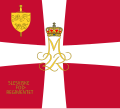| Schleswig Regiment of Foot | |
|---|---|
| Slesvigske Fodregiment | |
 | |
| Active | 1778–2001 2019–present |
| Disbanded | 1 January 2001 |
| Country | |
| Branch | |
| Role | Motorized infantry (1961-2000) Light infantry (2019-) |
| Size | Four battalions (1961-2000) Two battalion (2019-) |
| Garrison/HQ | Haderslev Kaserne |
| Motto(s) | Vaagen og tro (Vigilant and Faithful) |
| Commanders | |
| Current commander | Col Lars Nygaard |
| Insignia | |
| Regimental belt | |
| Colours |  |
The Schleswig Regiment of Foot (Danish : Slesvigske Fodregiment) is a Royal Danish Army infantry regiment. On 1 January 2001, the regiment was merged with the Queen's Life Regiment to form the Prince's Life Regiment. In 2018, it was announced that the regiment would be reestablished on 1 January 2019 as a light infantry battalion. [1]


